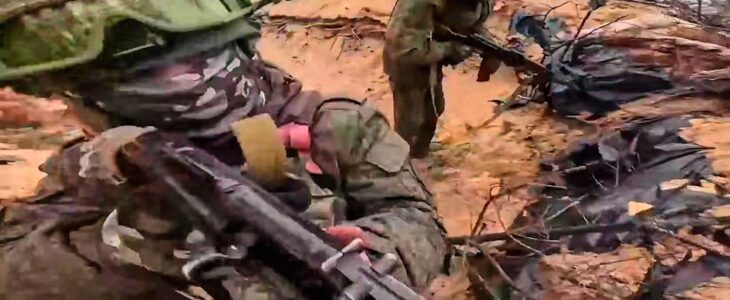
Sign inSearch the webhttps://9a977ee4782f244608e2fdcd40fd55fa.safeframe.googlesyndication.com/safeframe/1-0-45/html/container.html
Top Stories:
- Trump vs. Harvard: A timeline
- Allergies and climate change
- Kim Kardashian’s robbery trial
- Trump ramps up tariff threats
- Women in sports betting
- Transparent ‘phone’
- Skip the instant oatmeal
- Harvard foreign students
- Beef prices reach record highs
- Trump’s crypto dinner

The three-step Russian tactic driving back Ukraine
Verity BowmanFri, May 23, 2025 at 6:12 AM GMT+15 min read15



Russia’s ‘triple chokehold’ tactic driving Ukraine back
1 of 4The Russian military is said to be losing over 1,000 soldiers per day

Russia is deploying a military strategy known as the “triple chokehold” to grind down Ukrainian troops, according to experts.
Kyiv’s forces are facing severe pressure on multiple fronts while Russia works to edge them towards exhaustion by integrating three combat elements into a cohesive strategy greater than the sum of its parts.
Vladimir Putin’s forces are launching ground assaults to pin troops down, then dropping mines from drones and calling in strikes to restrict movement before glide bombs target defensive positions.
There were early signs that Russia was deploying the tactic on the battlefield earlier this year, The Telegraph was told – but Moscow’s armies have significantly increased its use over the last two months along the front line.
“The whole Russian army is using the triangle strategy,” said Serhii Kuzan, the chairman of the Ukrainian Security and Cooperation Centre. “We call it the strategy and war of exhaustion.”
Since the beginning of this year, Russia has been plagued by a depletion of resources and numerous failed offensives.
The country’s military is said to be losing over 1,000 soldiers per day, while Ukrainian armed forces have hit 1,159 Russian tanks, and more than 2,500 armoured vehicles since the start of 2025.
Heavy losses mean Russia is increasingly trying to press its key advantages over Ukraine – a steady supply of soldiers and an ability to quickly produce drones and glide bombs.
These efforts are proving effective, with Russia’s forces capturing close to 1,500 square miles of territory last year – its most significant gains since Putin launched his invasion in 2022.
“It’s a very attritional mode of warfare,” explained Nick Reynolds, research fellow for land warfare at the Royal United Services Institute (RUSI). “These three elements create conflicting imperatives for Ukrainian defenders.”
The methodical approach begins with ground assaults fighting to pin down Ukrainian troops, forcing them into defensive positions and stalling their ability to manoeuvre.
The continued assaults put heavy pressure on Ukrainian defences.
“By using huge numbers of people and sending them in assaults on Ukrainian positions, they are trying to exhaust our soldiers and our resources,” said Mr Kuzan. “The intensity of the fighting in places like Pokrovsk is very high, with assaults every two hours. This is of course exhausting for our soldiers.”

Next, drones are deployed to restrict Ukrainian mobility, conduct surveillance, target vulnerable points and disrupt troop movements by strategically drop mines.
These drones include first person view (FPV) drones, which allow Russian forces to track Ukrainian positions in real time and quickly respond to any troop movements, while mine-laying drones are used to cut off avenues of escape.
“Because of these drones, Ukraine is forced to man the front line with static defensive positions supported by extensive deception measures, for example, large-scale digging, to obscure where troops are actually concentrated,” said Mr Reynolds.
The third prong of the Triple Chokehold sees Russia deploy glide bombs to target key offensive positions from long distances, weakening Ukraine’s ability to sustain operations.
Glide bombs are built by adding fold-out wings and GPS navigation to old Soviet-era munitions. They are then released from military aircraft flying well behind the frontlines, and are guided to their target.
These long-range, precision-guided munitions have allowed Russia to use of its vast stockpiles of Soviet weaponry to target key Ukrainian positions, particularly artillery and defensive installations.
This is where the real dilemma comes, or the really difficult one, to which there isn’t really an answer,” said Mr Reynolds.
“Digging in and all those protective measures are excellent for reducing attrition by artillery or FPVs, yet glide bombs will destroy those fortifications and bury people.”
The combination forces Ukrainian soldiers to choose between holding their positions – risking heavy casualties and resource exhaustion – or staying mobile, which increases their exposure to drone strikes and isolated attacks.
“What pins Ukrainian forces in place is the combined threat of Russian ground operations, artillery, and drones, especially FPV and tactical unmanned aerial vehicles,” added Mr Reynolds.
Glide bombs have become the most critical element for this strategy, buoyed by Russia’s ability to churn them out quickly.
“Rates of Russian production and employment of glide bombs and FPV drones has greatly increased as the war has gone on,” John Hardie, the deputy director of the Russia Program at the Foundation for Defence of Democracies, told The Telegraph.
Russia plans to produce 75,000 glide bombs in 2025, averaging about 205 per day, according to RUSI, greatly increasing its ability to deploy the tactic.
Ukraine has adapted to the triple chokehold by shifting to a dynamic defence strategy – constant repositioning and unpredictability, rather than holding fixed positions.
It is using a combination of mines, various models of strike drones and traditional artillery fire against Russian forces before they manage to search its undermanned infantry positions, according to Mr Hardie.
Ukraine has also expanded strike-drone units that serve as a key force multiplier, and dramatically increased production of FPV drones and other unmanned systems.

“The Ukrainians have become very adept and innovative about countering all types of Russian attack,” said Hamish de Bretton-Gordon, a former British Army colonel and chemical weapons expert.
The strategy has pushed Ukraine even further into a war of endurance. But as of yet, any gains are incremental for Russia, and the tactic has failed to result in any large-scale operational breakthroughs.
“Russia is fixing the Ukrainian forces but cannot manoeuvre to deliver a decisive blow,” said Mr de Bretton-Gordon.
The issues for Russia of under-trained soldiers and a lack of armoured vehicles remain unsolved. Witnesses have reported the use of motorbikes and even e-scooters by Russian troops to push towards Ukrainian defensive lines.
The glide bombs also have a significantly high failure rate.
“They have found it very difficult to concentrate force because this type of manoeuvre takes a lot of training and co-ordination,” said Mr de Bretton-Gordon.
“Most of the soldiers on the front line now are barely trained conscripts who can just attack in a straight line,” he added. “Many cannot even clean their rifles properly.”
Credit: Yahoo News
